Rickard Ewetz
Verifiable Natural Language to Linear Temporal Logic Translation: A Benchmark Dataset and Evaluation Suite
Jul 01, 2025Abstract:Empirical evaluation of state-of-the-art natural-language (NL) to temporal-logic (TL) translation systems reveals near-perfect performance on existing benchmarks. However, current studies measure only the accuracy of the translation of NL logic into formal TL, ignoring a system's capacity to ground atomic propositions into new scenarios or environments. This is a critical feature, necessary for the verification of resulting formulas in a concrete state space. Consequently, most NL-to-TL translation frameworks propose their own bespoke dataset in which the correct grounding is known a-priori, inflating performance metrics and neglecting the need for extensible, domain-general systems. In this paper, we introduce the Verifiable Linear Temporal Logic Benchmark ( VLTL-Bench), a unifying benchmark that measures verification and verifiability of automated NL-to-LTL translation. The dataset consists of three unique state spaces and thousands of diverse natural language specifications and corresponding formal specifications in temporal logic. Moreover, the benchmark contains sample traces to validate the temporal logic expressions. While the benchmark directly supports end-to-end evaluation, we observe that many frameworks decompose the process into i) lifting, ii) grounding, iii) translation, and iv) verification. The benchmark provides ground truths after each of these steps to enable researches to improve and evaluate different substeps of the overall problem. To encourage methodologically sound advances in verifiable NL-to-LTL translation approaches, we release VLTL-Bench here: https://www.kaggle.com/datasets/dubascudes/vltl bench.
NSP: A Neuro-Symbolic Natural Language Navigational Planner
Sep 10, 2024Abstract:Path planners that can interpret free-form natural language instructions hold promise to automate a wide range of robotics applications. These planners simplify user interactions and enable intuitive control over complex semi-autonomous systems. While existing symbolic approaches offer guarantees on the correctness and efficiency, they struggle to parse free-form natural language inputs. Conversely, neural approaches based on pre-trained Large Language Models (LLMs) can manage natural language inputs but lack performance guarantees. In this paper, we propose a neuro-symbolic framework for path planning from natural language inputs called NSP. The framework leverages the neural reasoning abilities of LLMs to i) craft symbolic representations of the environment and ii) a symbolic path planning algorithm. Next, a solution to the path planning problem is obtained by executing the algorithm on the environment representation. The framework uses a feedback loop from the symbolic execution environment to the neural generation process to self-correct syntax errors and satisfy execution time constraints. We evaluate our neuro-symbolic approach using a benchmark suite with 1500 path-planning problems. The experimental evaluation shows that our neuro-symbolic approach produces 90.1% valid paths that are on average 19-77% shorter than state-of-the-art neural approaches.
Data Augmentation for Image Classification using Generative AI
Aug 31, 2024Abstract:Scaling laws dictate that the performance of AI models is proportional to the amount of available data. Data augmentation is a promising solution to expanding the dataset size. Traditional approaches focused on augmentation using rotation, translation, and resizing. Recent approaches use generative AI models to improve dataset diversity. However, the generative methods struggle with issues such as subject corruption and the introduction of irrelevant artifacts. In this paper, we propose the Automated Generative Data Augmentation (AGA). The framework combines the utility of large language models (LLMs), diffusion models, and segmentation models to augment data. AGA preserves foreground authenticity while ensuring background diversity. Specific contributions include: i) segment and superclass based object extraction, ii) prompt diversity with combinatorial complexity using prompt decomposition, and iii) affine subject manipulation. We evaluate AGA against state-of-the-art (SOTA) techniques on three representative datasets, ImageNet, CUB, and iWildCam. The experimental evaluation demonstrates an accuracy improvement of 15.6% and 23.5% for in and out-of-distribution data compared to baseline models, respectively. There is also a 64.3% improvement in SIC score compared to the baselines.
Neuro Symbolic Reasoning for Planning: Counterexample Guided Inductive Synthesis using Large Language Models and Satisfiability Solving
Sep 28, 2023



Abstract:Generative large language models (LLMs) with instruct training such as GPT-4 can follow human-provided instruction prompts and generate human-like responses to these prompts. Apart from natural language responses, they have also been found to be effective at generating formal artifacts such as code, plans, and logical specifications from natural language prompts. Despite their remarkably improved accuracy, these models are still known to produce factually incorrect or contextually inappropriate results despite their syntactic coherence - a phenomenon often referred to as hallucination. This limitation makes it difficult to use these models to synthesize formal artifacts that are used in safety-critical applications. Unlike tasks such as text summarization and question-answering, bugs in code, plan, and other formal artifacts produced by LLMs can be catastrophic. We posit that we can use the satisfiability modulo theory (SMT) solvers as deductive reasoning engines to analyze the generated solutions from the LLMs, produce counterexamples when the solutions are incorrect, and provide that feedback to the LLMs exploiting the dialog capability of instruct-trained LLMs. This interaction between inductive LLMs and deductive SMT solvers can iteratively steer the LLM to generate the correct response. In our experiments, we use planning over the domain of blocks as our synthesis task for evaluating our approach. We use GPT-4, GPT3.5 Turbo, Davinci, Curie, Babbage, and Ada as the LLMs and Z3 as the SMT solver. Our method allows the user to communicate the planning problem in natural language; even the formulation of queries to SMT solvers is automatically generated from natural language. Thus, the proposed technique can enable non-expert users to describe their problems in natural language, and the combination of LLMs and SMT solvers can produce provably correct solutions.
Neural Stochastic Differential Equations for Robust and Explainable Analysis of Electromagnetic Unintended Radiated Emissions
Sep 27, 2023Abstract:We present a comprehensive evaluation of the robustness and explainability of ResNet-like models in the context of Unintended Radiated Emission (URE) classification and suggest a new approach leveraging Neural Stochastic Differential Equations (SDEs) to address identified limitations. We provide an empirical demonstration of the fragility of ResNet-like models to Gaussian noise perturbations, where the model performance deteriorates sharply and its F1-score drops to near insignificance at 0.008 with a Gaussian noise of only 0.5 standard deviation. We also highlight a concerning discrepancy where the explanations provided by ResNet-like models do not reflect the inherent periodicity in the input data, a crucial attribute in URE detection from stable devices. In response to these findings, we propose a novel application of Neural SDEs to build models for URE classification that are not only robust to noise but also provide more meaningful and intuitive explanations. Neural SDE models maintain a high F1-score of 0.93 even when exposed to Gaussian noise with a standard deviation of 0.5, demonstrating superior resilience to ResNet models. Neural SDE models successfully recover the time-invariant or periodic horizontal bands from the input data, a feature that was conspicuously missing in the explanations generated by ResNet-like models. This advancement presents a small but significant step in the development of robust and interpretable models for real-world URE applications where data is inherently noisy and assurance arguments demand interpretable machine learning predictions.
Integrated Decision Gradients: Compute Your Attributions Where the Model Makes Its Decision
May 31, 2023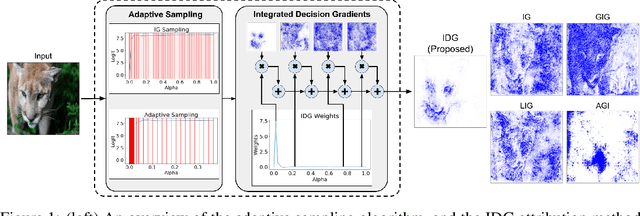
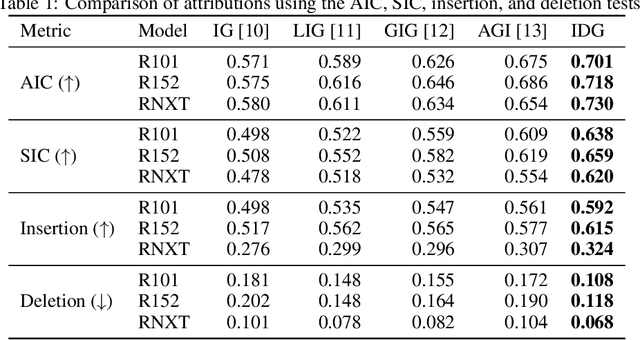
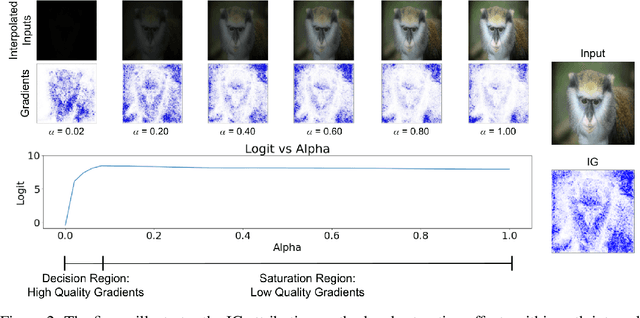
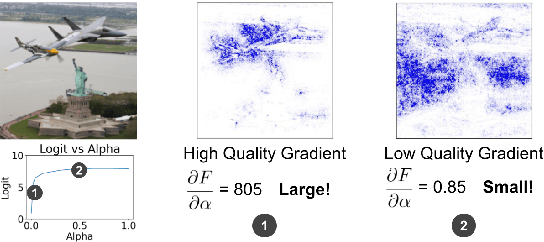
Abstract:Attribution algorithms are frequently employed to explain the decisions of neural network models. Integrated Gradients (IG) is an influential attribution method due to its strong axiomatic foundation. The algorithm is based on integrating the gradients along a path from a reference image to the input image. Unfortunately, it can be observed that gradients computed from regions where the output logit changes minimally along the path provide poor explanations for the model decision, which is called the saturation effect problem. In this paper, we propose an attribution algorithm called integrated decision gradients (IDG). The algorithm focuses on integrating gradients from the region of the path where the model makes its decision, i.e., the portion of the path where the output logit rapidly transitions from zero to its final value. This is practically realized by scaling each gradient by the derivative of the output logit with respect to the path. The algorithm thereby provides a principled solution to the saturation problem. Additionally, we minimize the errors within the Riemann sum approximation of the path integral by utilizing non-uniform subdivisions determined by adaptive sampling. In the evaluation on ImageNet, it is demonstrated that IDG outperforms IG, left-IG, guided IG, and adversarial gradient integration both qualitatively and quantitatively using standard insertion and deletion metrics across three common models.
On the Robustness of AlphaFold: A COVID-19 Case Study
Jan 12, 2023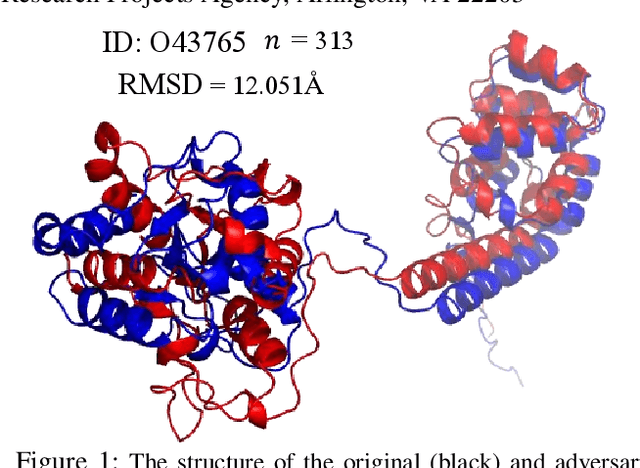
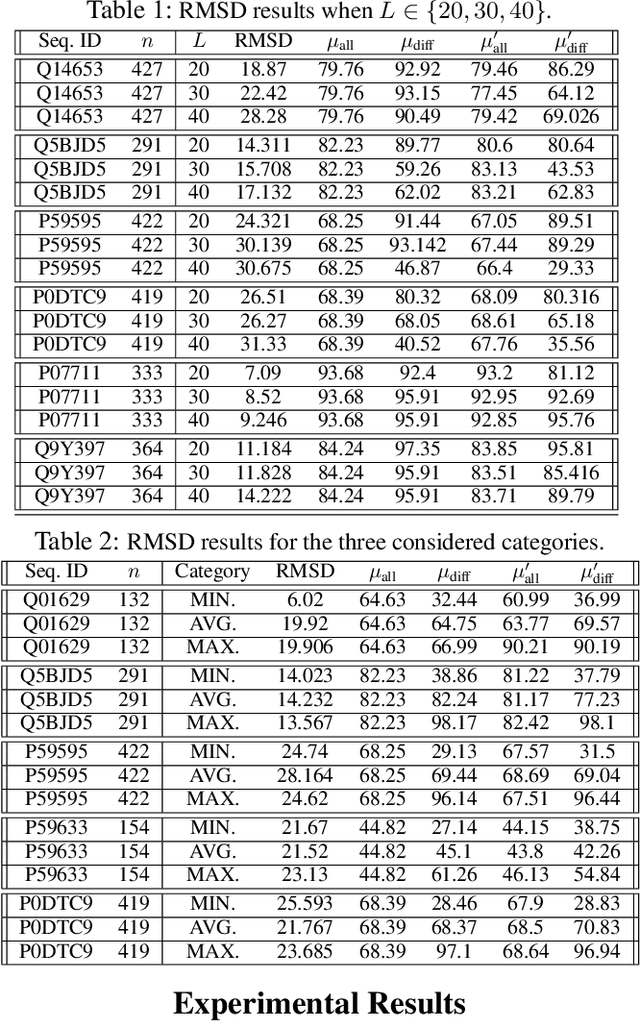
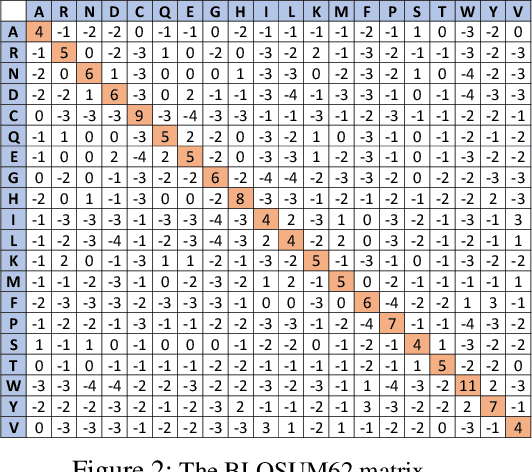

Abstract:Protein folding neural networks (PFNNs) such as AlphaFold predict remarkably accurate structures of proteins compared to other approaches. However, the robustness of such networks has heretofore not been explored. This is particularly relevant given the broad social implications of such technologies and the fact that biologically small perturbations in the protein sequence do not generally lead to drastic changes in the protein structure. In this paper, we demonstrate that AlphaFold does not exhibit such robustness despite its high accuracy. This raises the challenge of detecting and quantifying the extent to which these predicted protein structures can be trusted. To measure the robustness of the predicted structures, we utilize (i) the root-mean-square deviation (RMSD) and (ii) the Global Distance Test (GDT) similarity measure between the predicted structure of the original sequence and the structure of its adversarially perturbed version. We prove that the problem of minimally perturbing protein sequences to fool protein folding neural networks is NP-complete. Based on the well-established BLOSUM62 sequence alignment scoring matrix, we generate adversarial protein sequences and show that the RMSD between the predicted protein structure and the structure of the original sequence are very large when the adversarial changes are bounded by (i) 20 units in the BLOSUM62 distance, and (ii) five residues (out of hundreds or thousands of residues) in the given protein sequence. In our experimental evaluation, we consider 111 COVID-19 proteins in the Universal Protein resource (UniProt), a central resource for protein data managed by the European Bioinformatics Institute, Swiss Institute of Bioinformatics, and the US Protein Information Resource. These result in an overall GDT similarity test score average of around 34%, demonstrating a substantial drop in the performance of AlphaFold.
Protein Folding Neural Networks Are Not Robust
Sep 19, 2021



Abstract:Deep neural networks such as AlphaFold and RoseTTAFold predict remarkably accurate structures of proteins compared to other algorithmic approaches. It is known that biologically small perturbations in the protein sequence do not lead to drastic changes in the protein structure. In this paper, we demonstrate that RoseTTAFold does not exhibit such a robustness despite its high accuracy, and biologically small perturbations for some input sequences result in radically different predicted protein structures. This raises the challenge of detecting when these predicted protein structures cannot be trusted. We define the robustness measure for the predicted structure of a protein sequence to be the inverse of the root-mean-square distance (RMSD) in the predicted structure and the structure of its adversarially perturbed sequence. We use adversarial attack methods to create adversarial protein sequences, and show that the RMSD in the predicted protein structure ranges from 0.119\r{A} to 34.162\r{A} when the adversarial perturbations are bounded by 20 units in the BLOSUM62 distance. This demonstrates very high variance in the robustness measure of the predicted structures. We show that the magnitude of the correlation (0.917) between our robustness measure and the RMSD between the predicted structure and the ground truth is high, that is, the predictions with low robustness measure cannot be trusted. This is the first paper demonstrating the susceptibility of RoseTTAFold to adversarial attacks.
An Extension of Fano's Inequality for Characterizing Model Susceptibility to Membership Inference Attacks
Sep 17, 2020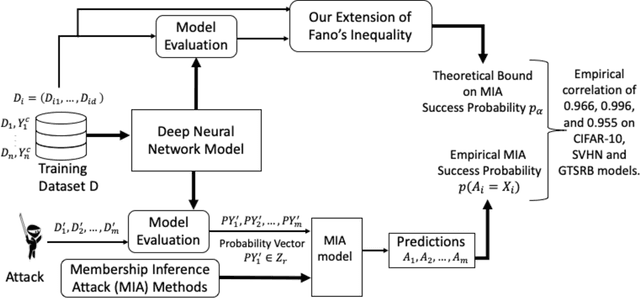
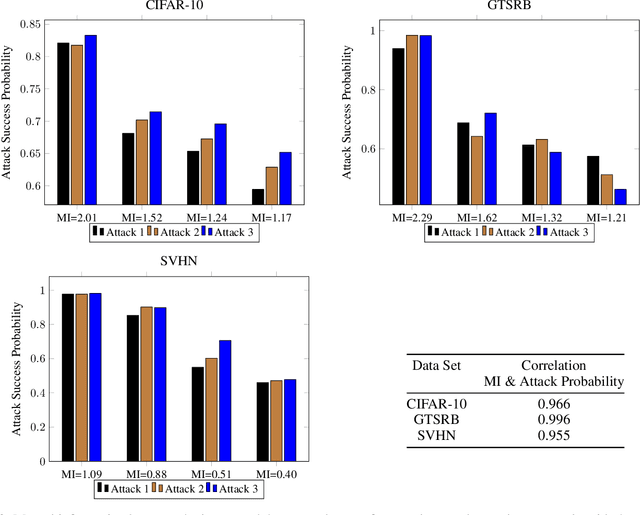
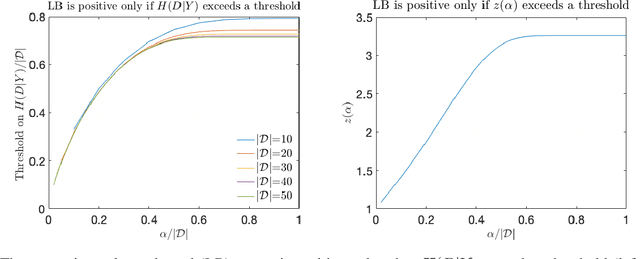
Abstract:Deep neural networks have been shown to be vulnerable to membership inference attacks wherein the attacker aims to detect whether specific input data were used to train the model. These attacks can potentially leak private or proprietary data. We present a new extension of Fano's inequality and employ it to theoretically establish that the probability of success for a membership inference attack on a deep neural network can be bounded using the mutual information between its inputs and its activations. This enables the use of mutual information to measure the susceptibility of a DNN model to membership inference attacks. In our empirical evaluation, we show that the correlation between the mutual information and the susceptibility of the DNN model to membership inference attacks is 0.966, 0.996, and 0.955 for CIFAR-10, SVHN and GTSRB models, respectively.
Representable Matrices: Enabling High Accuracy Analog Computation for Inference of DNNs using Memristors
Nov 27, 2019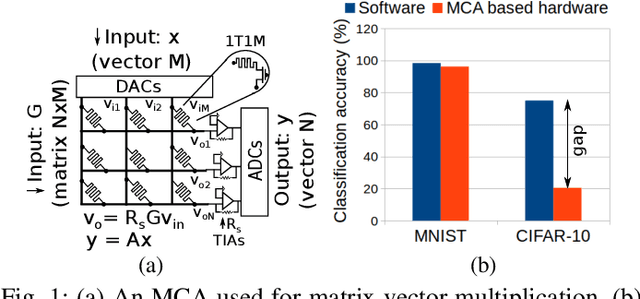
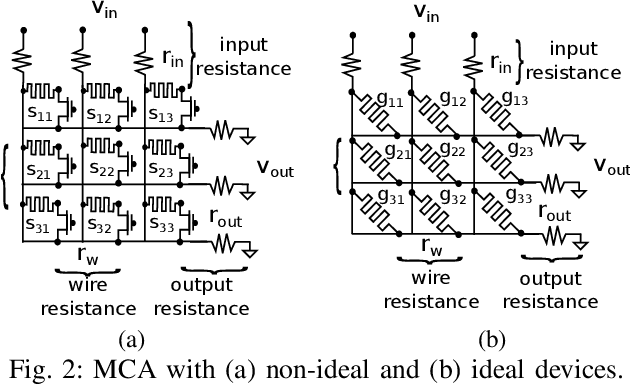

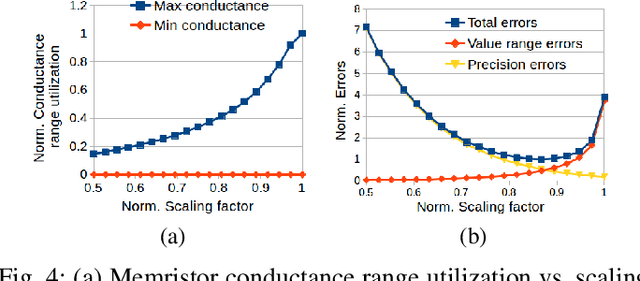
Abstract:Analog computing based on memristor technology is a promising solution to accelerating the inference phase of deep neural networks (DNNs). A fundamental problem is to map an arbitrary matrix to a memristor crossbar array (MCA) while maximizing the resulting computational accuracy. The state-of-the-art mapping technique is based on a heuristic that only guarantees to produce the correct output for two input vectors. In this paper, a technique that aims to produce the correct output for every input vector is proposed, which involves specifying the memristor conductance values and a scaling factor realized by the peripheral circuitry. The key insight of the paper is that the conductance matrix realized by an MCA is only required to be proportional to the target matrix. The selection of the scaling factor between the two regulates the utilization of the programmable memristor conductance range and the representability of the target matrix. Consequently, the scaling factor is set to balance precision and value range errors. Moreover, a technique of converting conductance values into state variables and vice versa is proposed to handle memristors with non-ideal device characteristics. Compared with the state-of-the-art technique, the proposed mapping results in 4X-9X smaller errors. The improvements translate into that the classification accuracy of a seven-layer convolutional neural network (CNN) on CIFAR-10 is improved from 20.5% to 71.8%.
 Add to Chrome
Add to Chrome Add to Firefox
Add to Firefox Add to Edge
Add to Edge